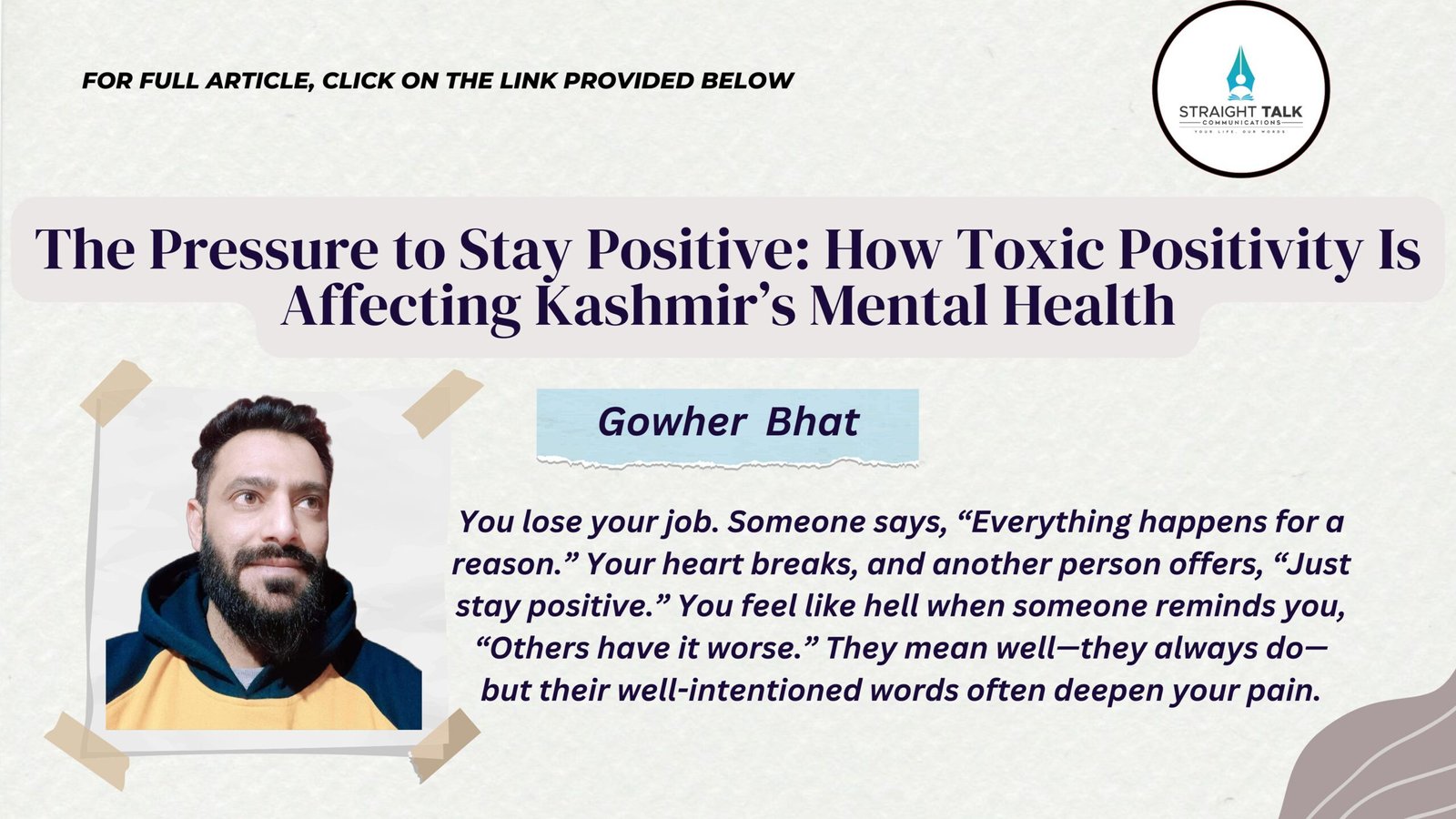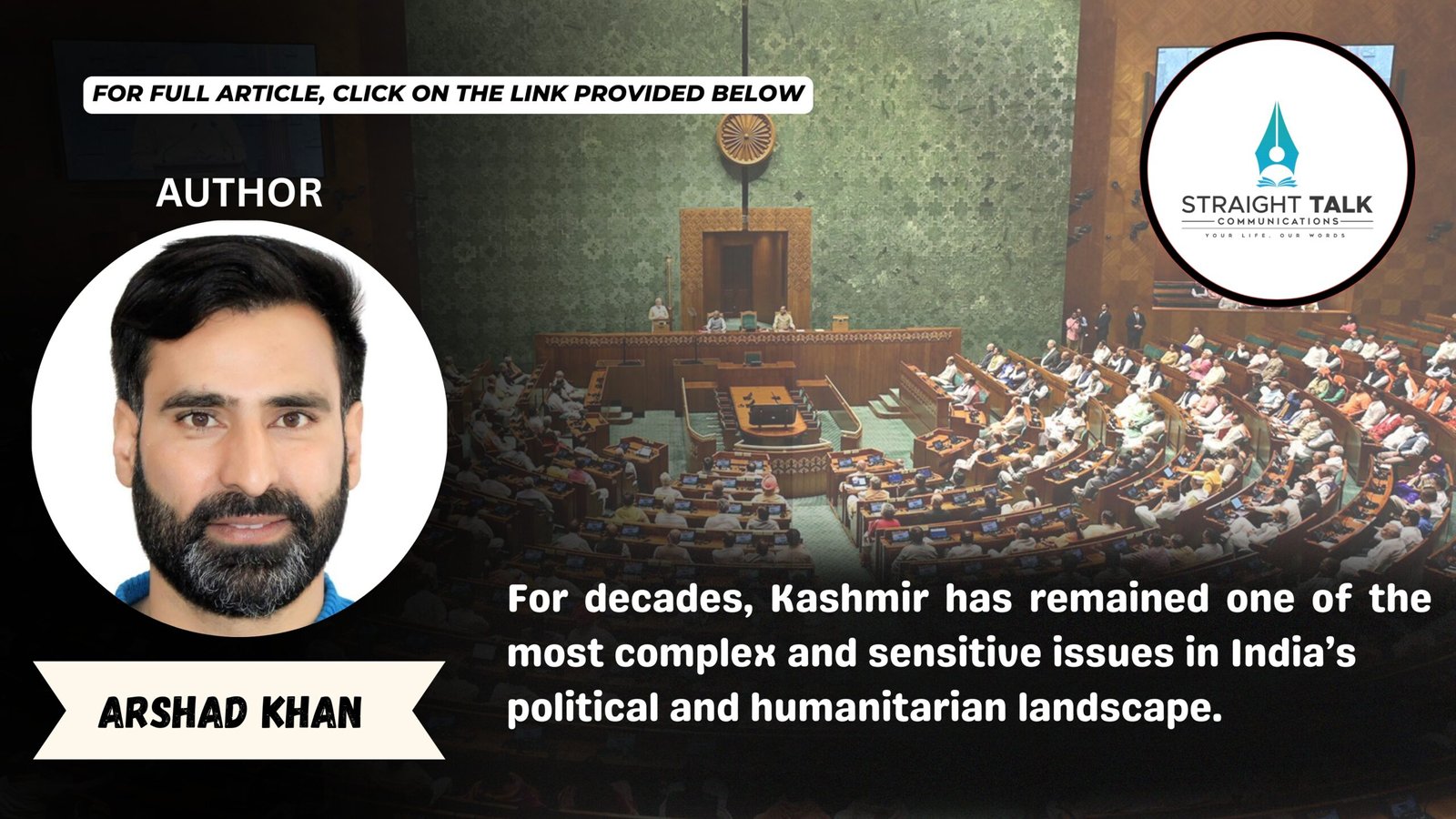The Pressure to Stay Positive: How Toxic Positivity Is Affecting Kashmir’s Mental Health

Gowher Bhat
You lose your job. Someone says, “Everything happens for a reason.” Your heart breaks, and another person offers, “Just stay positive.” You feel like hell when someone reminds you, “Others have it worse.” They mean well—they always do—but their well-intentioned words often deepen your pain. Along with your loss comes an unexpected burden: guilt. Guilt for not being positive enough, for feeling like your pain is too heavy or that you’re overreacting. Perhaps if you just tried harder, smiled more, counted your blessings—you’d see the bright side.
This kind of forced optimism has a name: toxic positivity. It lurks in the inspirational quotes we scroll past on Instagram, in the familiar smiles of friends who change the subject when you speak your truth, and even in the comforting voice of a relative pouring kehwa beside you on a winter morning. It’s the idea that no matter how hard life gets, you must suppress your tears and focus only on the silver linings—because, after all, “someone else has it worse.” But life, as we all know in our quietest moments, doesn’t work that way.
Optimism, when grounded in empathy, is undeniably powerful. It gives us hope, allows us to rise after a fall, and offers comfort in the darkest nights. But toxic positivity is something else entirely. It demands emotional perfection, a continuous smile, and relentless gratitude—even when life is crumbling.
Imagine this: you’ve been searching for a job for months despite holding a postgraduate degree. Every day feels like a battle against rejection and self-doubt. Then a friend casually says, “At least you’re educated—some people don’t even have that.” Or worse, “Maybe you’re just being too picky.” Or imagine losing a loved one—an ache that settles in your bones—and someone quickly remarks, “Time heals everything.”
In a place like Kashmir, where natural disasters like earthquakes and floods, and ongoing financial uncertainty and unemployment aren’t strangers, such responses can feel especially hollow. When a person who has recently lost their source of income is told to “just have faith” or “be grateful for what you have,” it can invalidate their very real and immediate needs.
Suppressing emotions doesn’t erase them. It merely buries them deeper, where they fester in silence. You might force a smile, laugh at jokes that don’t land, and keep showing up to social events even as your heart silently pleads for rest. But the body remembers. The soul remembers. Unfelt grief often returns through insomnia, persistent fatigue, unexplained anxiety, or sudden emotional breakdowns. A 2022 study published in the Journal of Psychological Science revealed that suppressing emotions can increase stress levels by up to 30%, and chronic emotional suppression may contribute to long-term health issues, including depression, cardiovascular disease, and weakened immunity.
Take a moment to think: Have you ever strolled quietly beside Dal Lake at dusk, hoping the silence would soothe you, only to find yourself feeling even heavier than before? Have you ever returned from a family gathering, having smiled all evening, only to break down once alone? These moments are not weakness. They are the soul’s attempt to be heard.
As psychologist Dr. Susan David, author of Emotional Agility, wisely says, “Emotions are data. They tell us what matters. When we suppress them, we lose sight of what our values are.” Her perspective encourages us not to run from pain but to walk with it—to understand it. Your sadness, your anger, your grief—they are not problems to fix. They are signposts guiding you to what you truly care about.
This view is echoed by Indian mental health professionals as well. Dr. Mansoor Ahmad, Head of Psychiatry at Government Medical College in Anantnag, emphasizes that “denying negative emotions doesn’t help anyone heal—it only delays the healing process.”
Similarly, Dr. Zoya Mir, a clinical psychologist based in Srinagar, notes, “The pressure to appear emotionally fine, especially among young adults and working professionals, can create a disconnect between what they feel and what they show.” This emotional dissonance, she explains, is fertile ground for chronic stress, anxiety, and depression.
In our modern world, social media has made happiness not just desirable but performative. Platforms like Instagram, Facebook, and Snapchat have become curated galleries of joy. We scroll through radiant smiles, aesthetic coffees, scenic hikes, perfect relationships, and captions like “Feeling blessed” or “Choose happiness.” But behind those polished posts, many are barely holding it together.
A 2023 survey by the Pew Research Center found that 59% of young adults in India and 62% of users aged 18–29 in the United States reported feeling more anxious or inadequate after comparing their real lives to social media portrayals. In Kashmir, where access to opportunities is already scarce and struggles are manifold, such digital comparisons can intensify feelings of despair.
Behind every chinar-filled picnic photo could be a battle with financial insecurity. Behind every dreamy wedding post might be a story of complicated family dynamics or unspoken grief. But social media doesn’t show that. It doesn’t capture the breakdown after the camera is off. It doesn’t record the nights when the weight of the world becomes unbearable. And so, we scroll, smile, and spiral deeper into isolation—wondering why our reality doesn’t measure up.
It is precisely for this reason that we must give our negative emotions the dignity they deserve. They are not intruders but guests with a message. Pain isn’t something to bypass with platitudes. It’s something to sit with, to listen to, and to learn from. In fact, a 2023 report from the American Psychological Association found that individuals who acknowledge and accept their negative emotions report lower levels of anxiety, depression, and emotional fatigue. Rather than fight the storm, we must learn to dance in the rain.
Think of the resilient willow trees that line the Jhelum. When strong winds rush through, they don’t resist. They sway, bend, and move with the storm—only to stand tall again when the winds subside. That is what true emotional strength looks like. It is not smiling through pain; it is honoring the pain, giving it space, and trusting in your ability to heal.
When someone is struggling, they don’t need clichés. They need presence. They need someone who looks them in the eye and says, “That sounds really hard. I may not have the right words, but I’m here.” Whether it’s grief, loneliness, unemployment, or illness—what truly helps is empathy, not empty reassurance. Offering someone a safe space to cry, rage, or just exist is far more healing than telling them to be strong.
Because real comfort lies not in erasing hurt, but in acknowledging it. Real healing begins not with “stay positive,” but with “I see you, I hear you, and your pain matters.” Emotional honesty is the foundation of genuine well-being. When we allow ourselves to feel the full spectrum of emotions—joy, sorrow, hope, despair—we begin to live more authentically. We begin to truly heal.
Here in Kashmir, where endurance has long been romanticized, it’s time to make space for softness too. We must create homes, friendships, workplaces, and communities where people are allowed to say: “I’m not okay.” And where the response is not discomfort or deflection—but compassion.
Whether it’s in the quiet corners of our homes, in the sacred solitude of tahajjud prayer, or in the warmth of a friend’s hug, we must normalize emotional honesty. Every day doesn’t need to offer a lesson or a silver lining. Some days, it’s enough to simply admit: “This hurts.” And that’s okay.
Because, like the chinar trees that shed their leaves only to bloom again in spring, we too must be allowed to fall and rise, break and mend, ache and heal. To be human is to feel, to falter, and to find light—not in forced smiles—but in the quiet strength of being real.
(The author is a published author, freelance journalist, creative writer, and experienced English instructor.)







